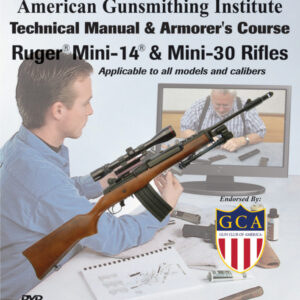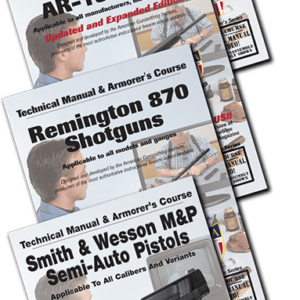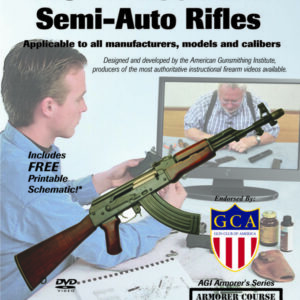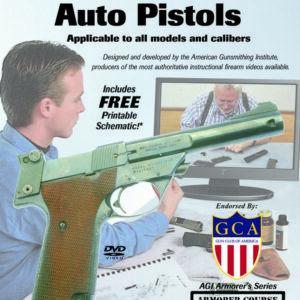Description
John Bush is an internationally renowned expert on the pasts military firearms. He is an expert witness and can tell what factory most parts were made in just by looking at them. He specializes in finding and selling parts for these guns for both the shooters and collectors markets. He understands the design, function, and repair of these firearms and has instructed our Armorers Courses on Submachine Guns and the Browning 1919RCMG. We use a cut-away gun to let you actually see how the rifle and all of its components operates. This course also covers building the FAL from a parts kit, barrel installation and headspacing, as well as identifying inch and metric guns.
If you want the quick course on how to get FNs classic select fire Battle Rifle apart, back together, and operating as intended, or building one from a parts kit, then this course is for you (if you want the long course, look into our basic 108 hour Professional Gunsmith Course.)
Among the items covered are:
History
- Rifles to be covered are FNs metric model, the C-1 from Canada, and the L1A1 from Australia
- After WW II most of the worlds armies wanted to re-arm with semi-autos
- Most of FNs engineers had gone to Britain when the factory was overrun by the Germans
- They originally designed the FN-49, and the FAL was descended from that gun, particularly the gas system
- Original FAL design also included the short cartridge used by the Germans in their MP-44, and was a smaller gun in 7mm Short
- What is the T-48?
- FAL was a supremely successful rifle used by almost 80 countries
- Most of the FN factories designs in the first half of the 20th Century were those of American John Moses Browning
- After WW I the Germans were forbidden to produce arms so FN (in Belgium) sold Mauser rifles all over the world in many different calibers
- The final FAL trigger group design was by way of Winchester, out of an American jailbird
- Quick way to spot an inch and metric gun
- Metric guns were first, many countries added their own features
- Who used what versions
- Which country was the only one to issue the FAL without a carrying handle?
- Civilian semi-auto version was built for the American market
- Early copies of this manual are valuable on the collectors market
- FN produced the rifle into the 1970s and the common wealth countries continued to produce it until the late 80s. As of the production of this course, it was still being produced in Argentina and Brazil
- Was replaced solely due to the caliber change to .223, one of the finest battle rifles ever built
Design & Function
- Basic firing cycle operation
- Last round hold open
- Bolt carrier/bolt and receiver interaction
- Locking shoulder shown
- The headspace can be adjusted in the field by replacing the locking shoulder
- Difference in configuration of the ejectors on inch and metric guns
- Full auto operation, the safety sear and carrier leg length difference
- Difference between select fire and semi-auto only safety
- Areas to inspect periodically on select fire guns
- Gas system operation
- How the gas volume acting on the piston is adjusted
- How the gas plug can completely shut off the gas to the piston
- Areas needing inspection, and what to look for
- Bolt and bolt carrier operation
- Correct firing pin protrusion, and 1 & 2 piece pins
- Operation of the rat tail, where it lives and what releases it
Disassembly
- Extensive disassembly, with discussion of what the various parts do. Parts not removed have their removal method explained, and/or the reason they should not be removed. Differences in the procedures for inch and metric guns explained
- Handguard removal
- Gas system disassembly
- Carry handle removal
- Separation of upper and lower receivers
- Upper receiver disassembly
- Lower receiver disassembly
- Rear sight and buttstock disassembly
- Bolt disassembly
- You get a good look at how the various parts fit together and interact (particularly the springs) after they are removed from the gun and John “explains” things
Cleaning & Lubrication
- AGI cleaning & lubrication methods shown, along with the reasons for their use
- After cleaning, dry with air gun, or in the oven on Warm ~185-200 degrees (metal parts ONLY)
Reassembly
- FAL special tools
- Bolt and carrier reassembly
- What to inspect on the extractor
- Lower receiver and buttstock
- Trigger, safety and hammer
- Upper receiver and gas tube reassembly
- Magazine catch and hold open reassembly
- Cocking handle reassembly
- Gas piston, tube, and gas plug reassembly
- Handguards, bolt carrier and top cover
- Lubrication and final reassembly
How to Tell Inch From Metric (again)
- Lower receivers
- Either type of lower receiver will fit either style upper
- Barrels
- Either barrel will fit either receiver
- Israeli heavy barrel and Indian barrels have a slightly different thread but can be modified to fit the other receivers
- Magazines
- Which mags will work in both guns, and which will not
- Upper receivers
Building an FAL from a Parts Kit
- Legal warning. HEED!
- Parts kit inventory
- Barrel assembly and alignment
- Using breeching washers
Headspacing the FAL
- Use a receiver wrench! Failure to use a proper receiver wrench will surely ruin your receiver! AGI has receiver wrenches for sale at a very reasonable price.
- Tools to use to determine locking shoulder size requirement
- Differences between military and civilian Go/No Go Gauges
- Where to measure from to determine locking shoulder size
- Cross use of all barrels in all receivers, and how to make them fit
- The three things you need to do to use an inch kit on a metric receiver
- How to tell select fire receivers from semi-auto receivers
- Modifications you should make to convert a select fire bolt to semi only
- Converting the select fire safety to semi only
Accessories
- Magazines
- Mag loaders, the inch model will also load M-14/M1A mags
- Stocks, wood and synthetic, as well as various size buttpads
- Scope mounts
- Replacement gas plugs, with/without grenade launcher sights, etc.
- Jungle sight guards
- Muzzle brakes
- Bayonets
- Cleaning kits
- Tools
- Reference books
Final Thoughts
- Troubleshooting
- Gas adjustment
- Lubrication
Full Auto with the FAL
- Watch and eat your heart out if you live in a No Full Auto state
If you noticed how often the terms “explanation” and “demonstration” are used, you may be getting some idea of why this course is necessary for any FAL owner, or someone who intends to be.




